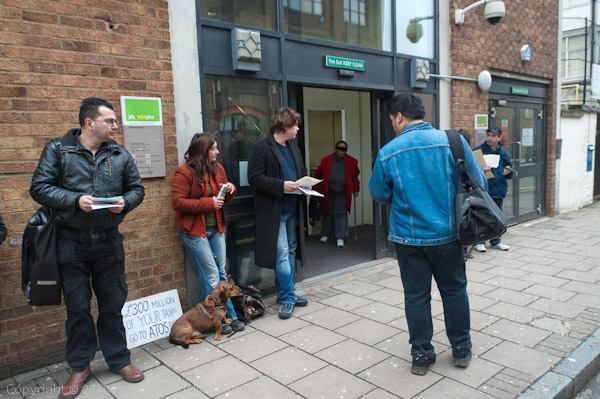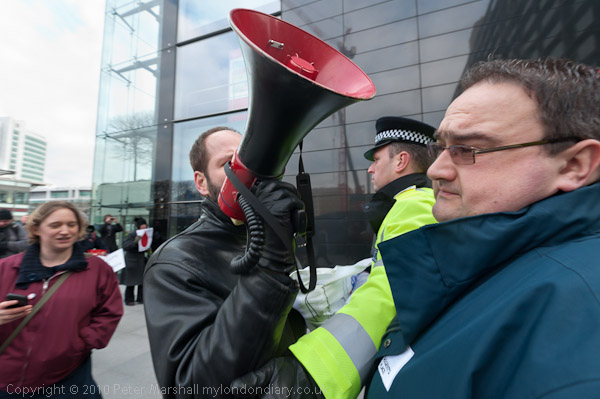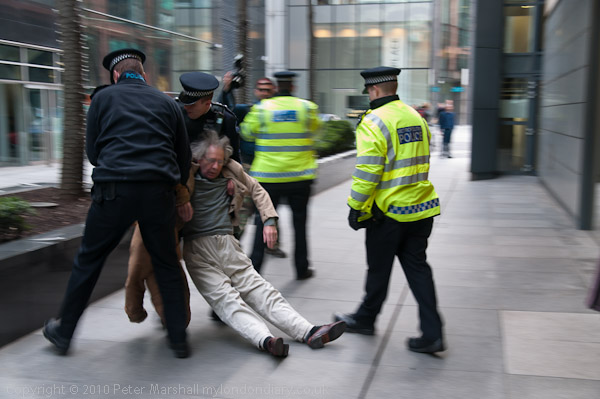Last Monday was a day of action against benefit cuts, and in particular targeted the company that runs the tests that people who want to claim the new Employment and Support Allowance (ESA) have to take (and retake at intervals.) The tests are an attempt to test their ability to work and are carried out by “trained healthcare professionals” employed by a private company, Atos Origin. As several of the placards said, ‘Atos Don’t Give A Toss.’
Although the amounts individual benefit claimants get are not generous they are essential for those concerned, and losing some or all of their benefit can be a personal catastrophe. Those who are assessed as able to work get benefit at a lower rate on the Job Seekers Allowance (JSA) and to get it have to keep showing evidence of looking for work, and may be refused all benefits if they are judged not to be doing so. Atos of course does rather better out of it, and despite a large volume of criticism about how poorly they do the job has just been awarded another £300 million contract.
Previously, doctors certified people as unfit to work, and there was occasionally a certain amount of unfairness involved – my own doctor was very loath to provide certificates while others were certainly over-generous. But the decisions were always based on a knowledge of the claimant and their circumstances and their medical conditions. Under the system used by Atos, an interview with set questions based on a computer system means that the needs and problems of the individuals are often neglected in reaching a decision.
Part of the problem has always been that there isn’t a simple division of people into those who are and those who are not fit for work, and of course that different types of work and different jobs within the same type of work place very different demands and stresses on workers. Add to that the problem of the availability of jobs in particular areas and we have a problem that is undeniably complex, and not one that the simplistic approach ofAtos’s ”work capability assessments’ can properly address. But they are happy just to take the money – and have just been given another £300 million despite a very critical report by an independent inspector appointed by the government and bodies such as Citizen’s Advice.

A man in a black mask comes out of the job centre!
The first photographs that I took were of a small protest, with I think eleven people handing out leaflets to people going in and out of a local job centre, one of many where these tests are carried out. There really wasn’t a great deal of action to photograph, and doing so was made a little more complex by my own decision not to identify the users of the job centre in my picture. I don’t think anyone has an expectation of privacy when going in or out of a job centre, but do feel that I might not like to be photographed in such a situation. I was happy to photograph both the protesters and any job centre staff who might be visible, but tried hard to make images in which the clients were only shown partially or from the back. In the end there were one or two pictures where there were identifiable people, mainly in the background of pictures, and there I either darkened the whole face or drew a black bar to obscure their eyes.
At that place I was working on the public street, but in the afternoon ‘party of protest’ I knew that I would be working in a ‘private place’, one of those increasing number of areas of the city open to the public but under private ownership. I was a little worried because the security staff there – as in many places around London – enforce a fairly strict ‘no photography’ policy.
I kept my cameras under my coat or in my bag until I was in the middle of the group of demonstrators, and then took them out and started pictures. At least I would be able, I thought, to get some pictures before I was approached and asked to stop – and of course I knew that neither the security men or the police had any power to ask me to delete them.

Security man and Police officer briefly stop a protester but ignore me
But there were no problems, at least not about taking pictures. Neither the police nor the private security men attempted to stop me, nor as far as I am aware anyone else taking pictures. Except when one elderly man walked through the police line and was pushed to the ground and then examined and dragged away by police. Then I had two problems.
First was the deliberate obstruction of my line of sight by two police officers. It seems to be deeply ingrained in many police that if they see a photographer taking pictures of an incident they should move to stand between them and it.
This seems to be the standard police interpretation of the paragraph from the ACPO Police-Media Guidelines (introduced by the Metropolitan Police in March 2006 and by other forces in 2007 following two years of negotiations with the BPPA, the NUJ and CIJ):
Members of the media have a duty to report from the scene of many of the incidents we have to deal with. We should actively help them carry out their responsibilities provided they do not interfere with ours.
The second problem that I faced was the D700, which chose this moment to have another of its hissy fits, and refuse to take pictures. I didn’t have time to argue with it, and picked up the D300 to shoot with that. It was set to a stop or two slower ISO and there wasn’t time for me to move the SB800 from the other camera to it, so I was working at a rather slower shutter speed than I would have liked. The blur really works quite well on one or two pictures, but there were others that were just blurred.

I’ve moved to one side of the officer in my way, while behind the incident
another officer moves to block a colleague
I’d already decided the D700 had to go in for repair, but just hadn’t had the time to take it in, but I did so the next day.
When I got back I wrote a fairly lengthy piece about the problems that disabled people are facing with ending of disability benefit and its partial replacement with the ESA to go with the pictures for Demotix. A few days later, with rather more pictures, this went onto My London Diary as Atos Tests Unfair to Disabled.